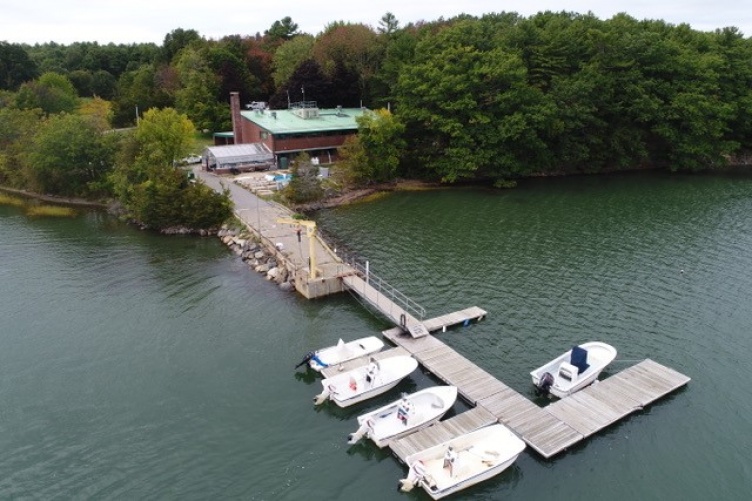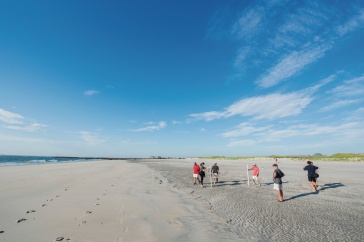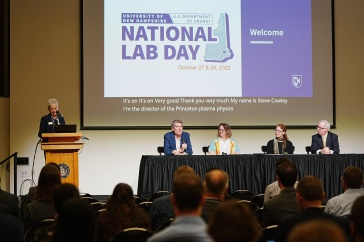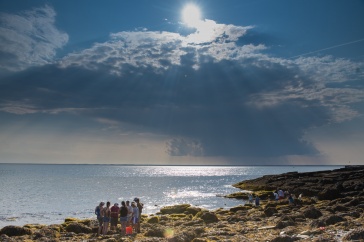
For the last 50 years, scientists and students have kept their fingers on the pulse of Great Bay and coastal New Hampshire thanks to a UNH outpost tucked along the shores of the state’s largest estuary. The Jackson Estuarine Laboratory (JEL), located on Great Bay’s Adams Point, celebrates its 50thanniversary this year — that’s five decades of research on microbes, oysters, seaweeds eelgrass, lobsters, horseshoe crabs, water quality and so much more. A lot has changed since 1970, but one thing has remained steadfast: JEL’s commitment to advancing the understanding and preservation of estuarine, coastal and marine ecosystems.
“Jackson Lab’s potential for field-based research is enormous,” says Diane Foster, director of the UNH School of Marine Sciences and Ocean Engineering, of which JEL is a part. “UNH has immense strengths in the coastal sciences, and the Great Bay Estuary serves as a living laboratory where JEL scientists can translate what’s happening in the bay to the changes happening to estuaries around the world. The expertise of JEL scientists advances our knowledge of human impacts, like climate change, and contributes adaptive solutions for our coastal resources,” she adds.

Hailed as one of the first academic labs in the nation designated solely for estuarine sciences, JEL serves as a vital resource for scientists and students to conduct their research, as well as local, state and federal natural resource management agencies that rely on critical ecological data collected by the lab’s scientists. Since 1970, JEL scientists have trained over 100 graduate students spanning two generations and have published upwards of 600 peer-reviewed journal articles on estuarine and marine-related topics.
Galen Jones, a UNH marine microbiologist, helped raise funds for the lab’s construction and served as its first director. The lab itself is named after UNH zoologist Floyd Jackson who conducted fisheries research in Great Bay.
Shortly after JEL’s construction, its researchers were involved in the fight to prevent the development of an oil refinery in the bay — an idea brought forth by Greek shipping magnate Aristotle Onassis that was successfully fended off thanks in part to the researchers’ data indicating that Great Bay could be irreparably harmed by its presence. A small dedicated team of JEL scientists later helped to establish the Great Bay Estuarine Research Reserve and paved the way for future researchers to continue studying local ecosystems.
David Burdick, research associate professor of coastal ecology and restoration and the director of JEL, says that the majority of scientists who work out of JEL are research faculty rather than academic faculty; this is an important distinction because “we can follow wherever the grant opportunities exist, so it puts us on the edge of science — we’re evolving and changing all the time,” he explains.
When Burdick first started working at UNH in 1990, JEL researchers were focused mainly on mitigating the effects of environmental issues after they occurred, whereas now they’re also taking a more proactive approach. To that end, he’s currently part of the UNH Coastal Habitat Restoration Team, a group of researchers who are focused on helping New England’s sand dunes and salt marshes thrive so they can protect the coast from storm surges and sea level rise.

“It’s great to have a team at the lab ready to deploy after an event. For example, after winter storm Greyson, Gregg Moore, research associate professor of biology, led a research team to document a large-scale sediment stranding event and gather information that the state will use to make decisions about long-term salt marsh resiliency and management,” he says.
Despite the relatively modest size and appearance of the building, JEL houses high-tech equipment that UNH research scientist Tom Gregory uses to analyze water quality and microbes and monitor environmental conditions via data buoys stationed around the bay. JEL’s docks provide a jumping off point for boat-based research and oyster reef restoration efforts. The wet lab — a glass greenhouse that holds large tanks of recirculating seawater — has recently provided a place for scientists to develop shrimp aquaculture protocols and learn about invasive green crab molting cues. It’s not unusual for visiting scholars and students from other universities to be in the mix, getting their hands wet for their own research studies. Elementary school students have previously taken field trips to the lab to learn about the life cycle of oysters — a nod to JEL’s capacity for outreach.
The lab’s scenic locale is an asset in itself. “The Jackson Estuarine Lab is a spectacular place, situated in a beautiful and ecologically complex area,” says Art Mathieson, professor emeritus of biological sciences who previously served as JEL’s second and longest-serving director.
JEL’s location has allowed researchers to conduct continuous monitoring of the bay right outside the lab’s backdoor. Long-term studies have revealed just how much Great Bay has changed in the last 50 years. Mathieson notes that the warmer water temperatures have encouraged many organisms typically found much farther south to move into the bay. “Different types of seaweeds, plants and animals that weren’t in the bay before are there now, they’ve taken over certain areas and impacted the region in a variety of ways,” he explains.

Beds of eelgrass, once plentiful in the bay, have struggled due to excess nitrogen and reduced light due to excessive seaweed growth. Fred Short, research professor emeritus of natural resources, developed the international SeagrassNet program to track and preserve seagrass meadows, including those in Great Bay. He has been sounding the alarm for years that nitrogen is impairing the system.
Not all the news from the bay is bad, though: Ray Grizzle, professor of zoology, has worked with volunteers and outside agencies to help restore oyster reef habitat and encourage population improvement. The estuary is now home to 16 commercial oyster farms. Steve Jones, research associate professor of natural resources and the environment, studies the various strains of Vibrio bacteria in the bay’s oysters to help protect human health. Much of the research that happens out at JEL is complementary, benefitting from a collaborative approach to solving real-world ecological challenges facing our local waters.
“There have been a lot of very talented scientists who have conducted research at Jackson Lab over the years,” Mathieson says.
A celebration to mark JEL’s 50th anniversary will be scheduled at a later date when it is deemed safe to gather as a group, Burdick says.
The Insititute for the Study of Earth, Oceans, and Space (EOS) is UNH's largest research enterprise, comprising six centers with a focus on interdisciplinary, high-impact research on Earth and climate systems, space science, the marine environment, seafloor mapping, and environmental acoustics. With more than $60 million in external funding secured annually, EOS fosters an intellectual and scientific environment that advances visionary scholarship and leadership in world-class research and graduate education.
-
Written By:
Rebecca Irelan | Institute for the Study of Earth, Oceans, and Space | rebecca.irelan@unh.edu | 603-862-0990



















































